4.2: Nervous System Structure and Terminology
This page is a draft and under active development. Please forward any questions, comments, and/or feedback to the ASCCC OERI (oeri@asccc.org).
( \newcommand{\kernel}{\mathrm{null}\,}\)
- Describe anatomical position and describe the location of at least two structures using anatomical direction terms
- Explain the difference between frontal (/coronal), transverse (/horizontal), and sagittal sectional planes
- Understand the six common divisions of the nervous system
- List the four major regions of the central nervous system
- Explain the structures that protect the brain and spinal cord
- Describe the components of the ventricular system in the brain and spinal cord
Overview
This module starts with anatomical position, sectional planes and directional terms and continues with the divisions of the nervous system. Some areas and structures of the central nervous system (brain and spinal cord) are then discussed, including the four major regions, the protective coverings, and the ventricular system.
Anatomical Orientation and Directions
Anatomical Position
When anatomists or health professionals identify the location of a structure in the human body, they do so in reference to a body in anatomical position. That is, they figure out the location based on the assumption that the body is starting out in anatomical position. Anatomical position for a human is when the human is standing up, facing forward, with arms extended to the sides, and palms facing out, as illustrated by two human models in Figure 4.2.1.
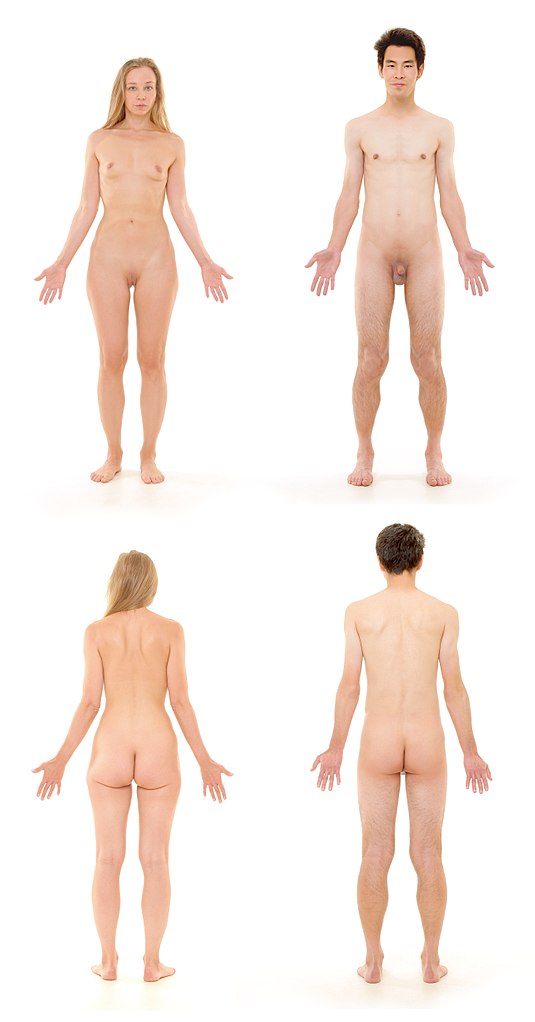
Female (left) and male (right) human body in anatomical position seen from anterior (upper) and posterior (lower) views.
When referencing a structure that is on one side of the body or the other, we use the terms “anatomical right” and “anatomical left.” Anatomical right means that the structure is on the side that a person in anatomical position would consider their right-hand side (not necessarily on the right of the viewer) and anatomical left means that the structure is the side that a person in anatomical position would consider their left-hand side (which likewise is not necessarily the left side of the viewer.)
Anatomical Planes
To view the interior of a body, we expose the organs and structures that are visible when that body is cut open along one of three commonly used sectional planes. These planes are the different directions a body is cut to reveal different views of its internal structures.
- Frontal (or coronal) plane—A vertical cut that separates the front from the back of the individual/structure.
- Transverse (or horizontal) plane—A horizontal cut that separates the top from the bottom of the individual/structure. (May also be called cross-sections.)
- Sagittal plane—A vertical cut that separates the left half from the right half of the individual/structure.
- Midsagittal (or median) plane—A vertical cut down the exact center line of the individual/structure that separates the left half from the right half.
- Parasagittal plane—A vertical cut that is off-center that separates the left of the individual/structure from the right in unequal portions. It does not matter whether it is the left side or the right side that is larger, as long as they are not equal.
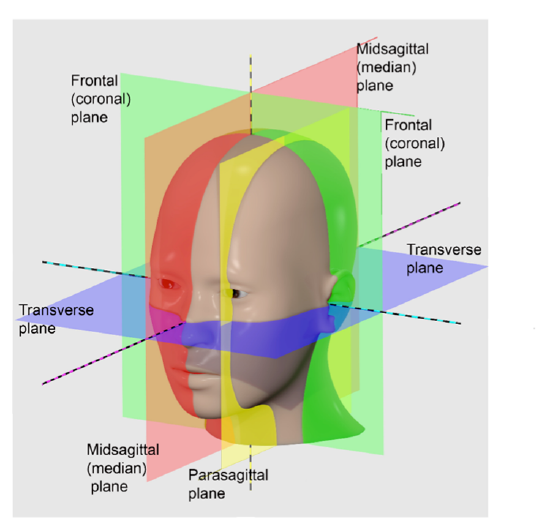
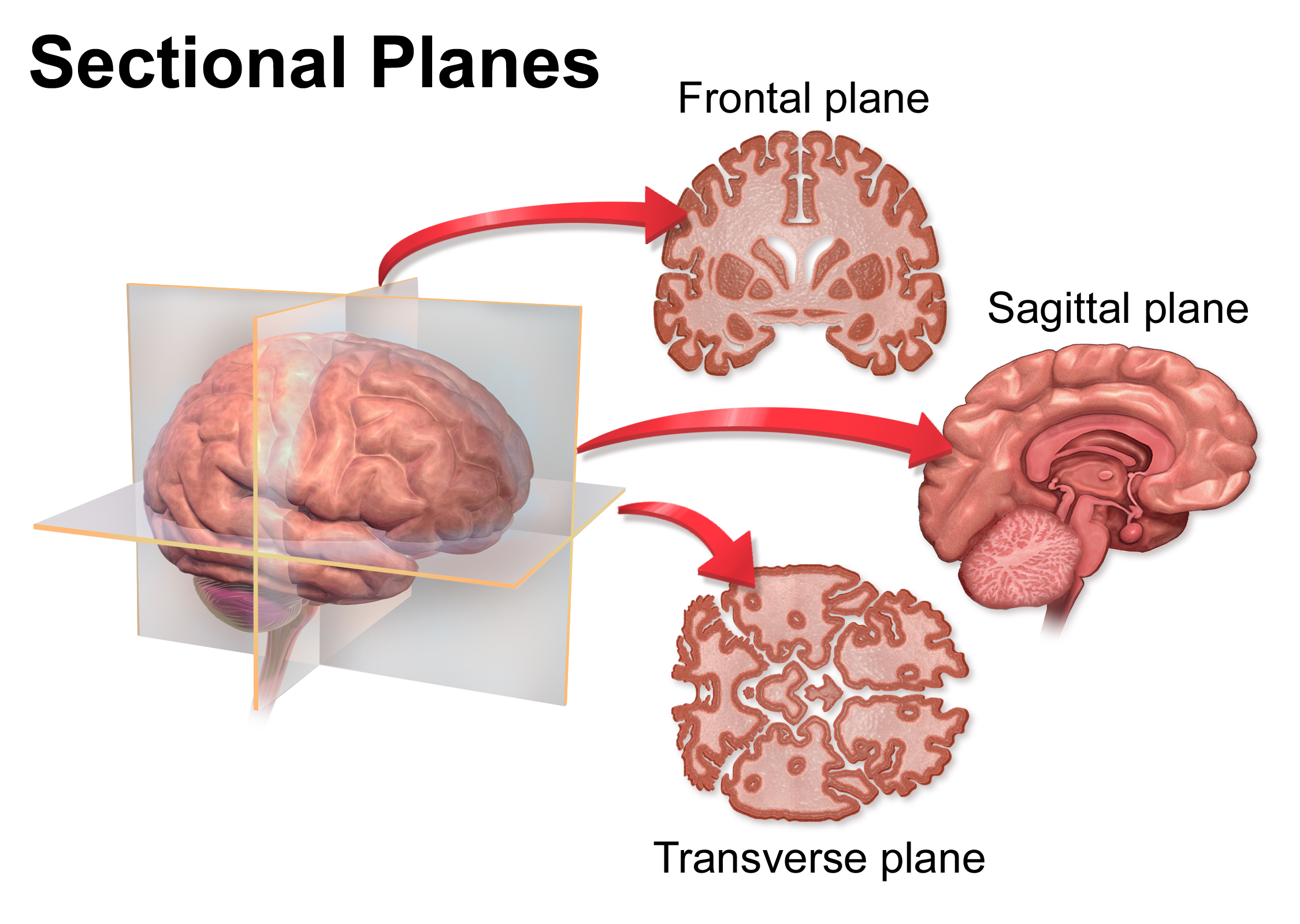
Anatomical Directional Terms
To be able to direct others to specific anatomical structures, or to find structures based on someone else’s directions, it is useful to have specific pairs of terms that allow you to orient your search with respect to the location of another known structure. The following pairs of terms are used to make comparisons. Each term is used to orient a first structure or feature with respect to the position of a second structure or feature. All of these terms refer to the body in anatomical position, and are illustrated in Figure 4.2.3.
- Superior/Inferior–Equivalent to above (superior) versus below (inferior) when moving along the long axis of the body. A structure that is superior to another is above the second structure. A feature that is inferior to another is below the second feature.
- Proximal/Distal–Equivalent to near (proximal) versus far (distal). Usually used to orient the positions of structures and features along the limbs with respect to the trunk of the body. A feature that is proximal to something else is closer to the limb’s point of attachment to the trunk. A structure that is distal to something else is farther away from the limb’s point of attachment. Although less precise, these terms are occasionally used in the trunk of the body itself to indicate whether something is closer to (proximal) or farther away from (distal) something else.
- Medial/Lateral–Equivalent to towards the middle (medial) versus towards the edge (lateral). These terms are used with respect to the midline of the trunk of the body. A structure that is medial to another is closer to the midline of the body’s trunk. A feature that is lateral to another is farther away from the midline of the trunk.
- Anterior/Posterior–Equivalent to the front (anterior) versus the back (posterior) of the body. A structure that is anterior to another is closer to the front of the body. A feature that is posterior to another is closer to the back of the body.
- Ventral/Dorsal–Equivalent to belly-side (ventral) versus back-side (dorsal) of the body. For a human in anatomical position, this pair of terms is largely equivalent to anterior versus posterior. However, for the head and brain, dorsal is on the top (superior) and ventral is on the bottom (inferior), whereas the front of the face would be anterior and the back of the head would be posterior. These terms match four-legged animals in what is considered their anatomical position, where the belly-side is not equivalent to the front of the animal. A structure below the human head that is ventral to another is closer to the belly-side of the body, whereas a feature that is dorsal to another is closer to the back of the body.
- Superficial/Deep–Equivalent to closer to the surface (superficial) versus farther from the surface (deep). A structure that is superficial to another is closer to the surface of the body. A feature that is deep to another is farther from the surface of the body.
- (Cephalic/Caudal–Equivalent to closer to the head (cephalic) versus closer to the tail (caudal). These terms are more useful for four-legged animals with tails than for upright humans with only a few vestigial tail bones and no visible tail- an area which is also not at the end of the body like the tail is in four-legged animals.)
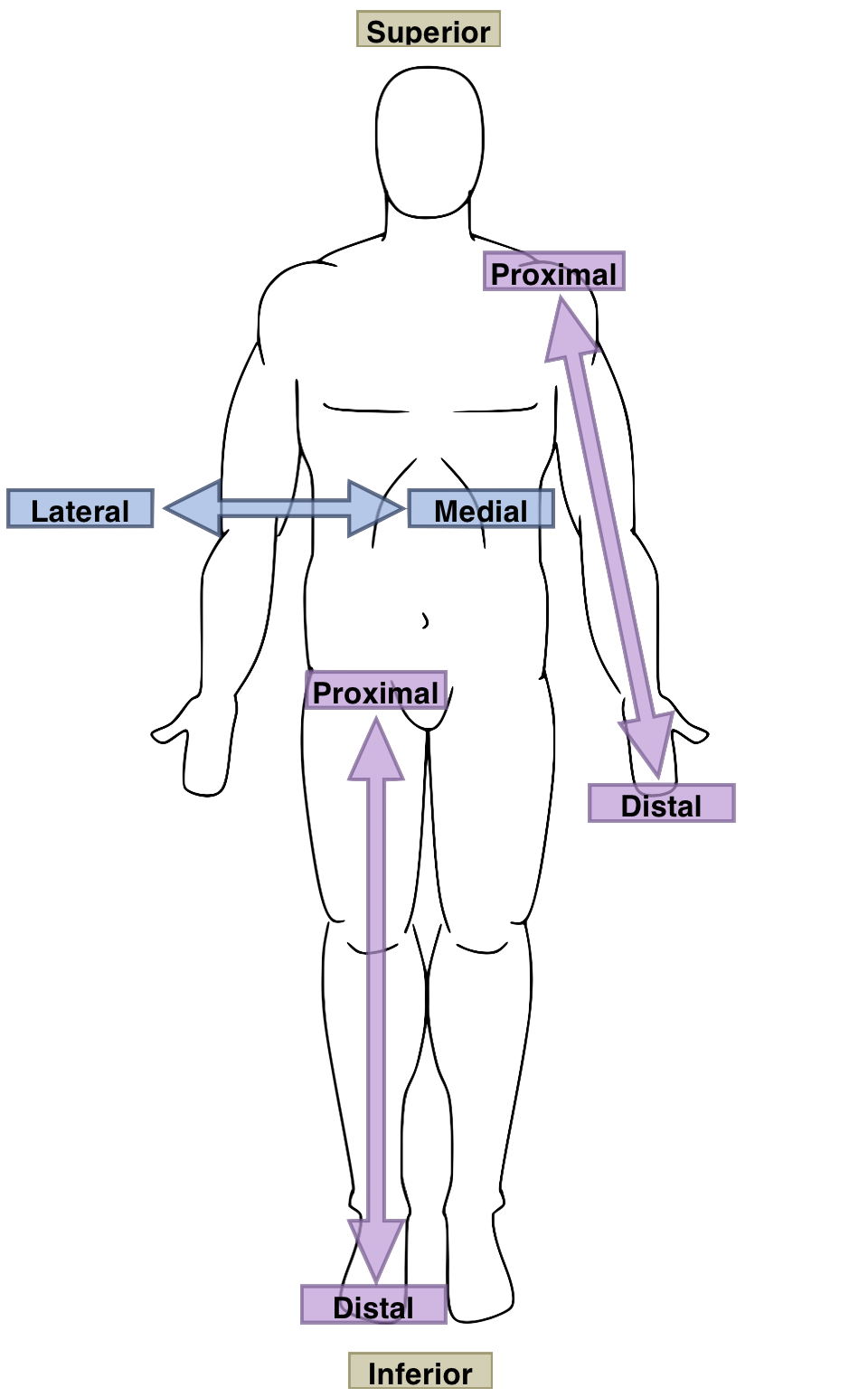
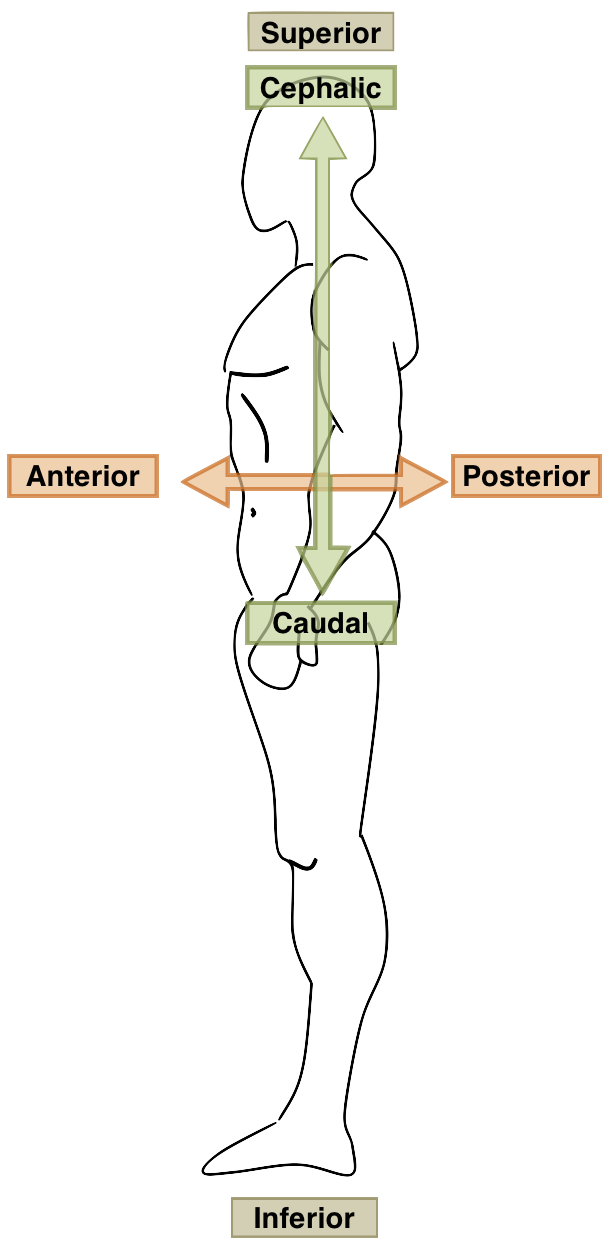
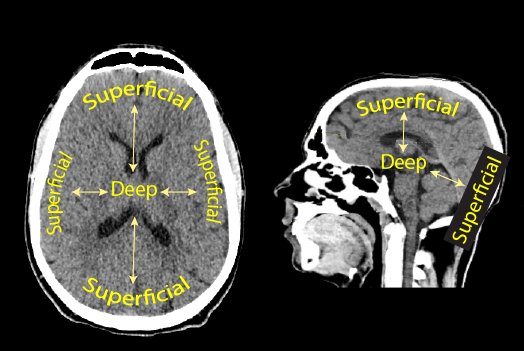
Organization of the Nervous System
As you might predict, the human nervous system is very complex. It has multiple divisions, beginning with its two main parts, the central nervous system (CNS) and the peripheral nervous system (PNS), as shown in Figure 4.2.4. The CNS includes the brain and spinal cord, and the PNS consists of all other nervous tissue in the body- mainly nerves, which are bundles of axons from sensory and motor neurons. The nerves of the PNS connect the CNS to the rest of the body.
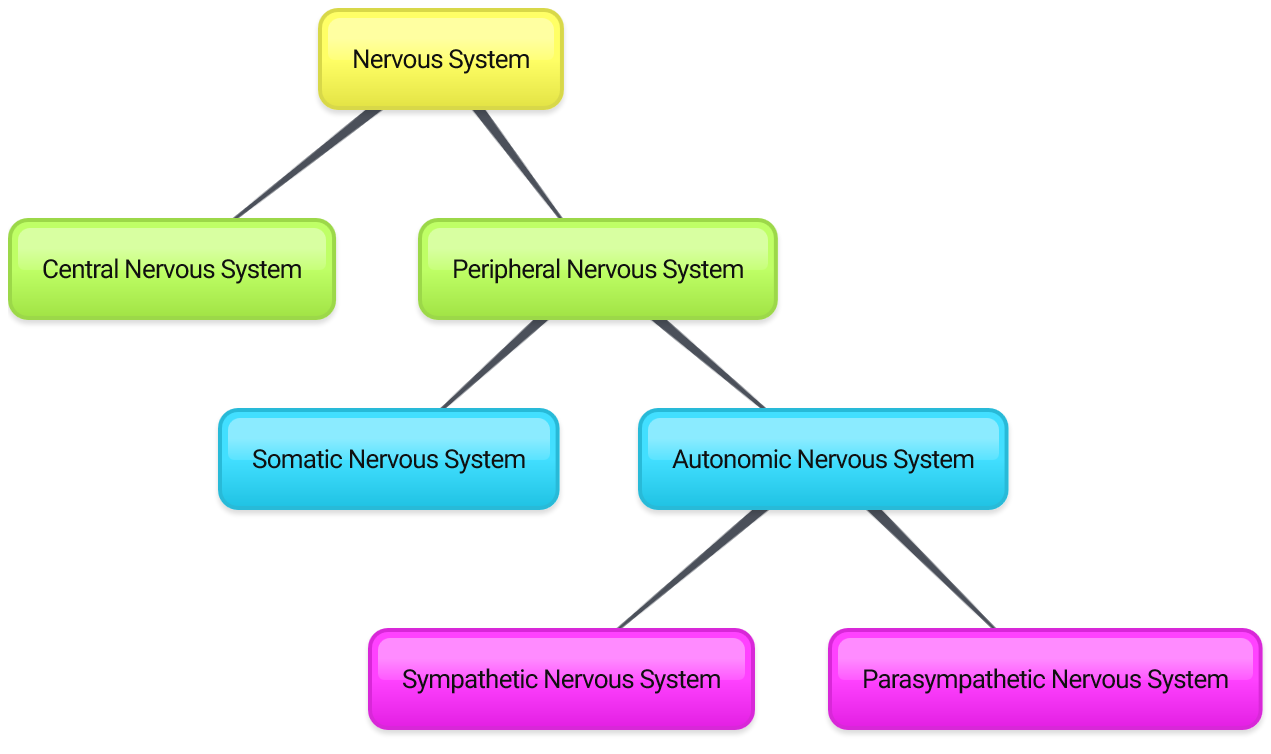
The PNS is divided into two major parts, called the autonomic and somatic nervous systems. The somatic nervous system (SNS) is responsible for activities that are under voluntary control and awareness, such as turning a steering wheel or feeling water splashing on your hands. The autonomic nervous system (ANS) controls involuntary activities, such as digesting a meal or regulating your heartbeat. The autonomic nervous system also has two divisions: the sympathetic and parasympathetic nervous systems. The sympathetic nervous system controls the "fight-or-flight" response during emergencies, and the parasympathetic nervous system controls the routine “housekeeping” functions of the body (sometimes referred to as the "rest and digest" division). Generally speaking, your body is usually activating a balance of sympathetic and parasympathetic functions.
The CNS and the sympathetic and parasympathetic branches of the ANS (itself a division of the PNS) are described in greater detail in other modules of this chapter. The other division of the PNS, the SNS, is composed largely of sensory receptors and their connections (covered in the sensory system chapter) and structures related to voluntary motor control (addressed in the movement chapter).
Central Nervous System Regions
Some commonly used terms referring to regions in the central nervous system (such as forebrain, midbrain, and hindbrain) derive from embryonic development and are discussed separately (see the module on development of the nervous system).
In its fully formed state, the CNS may be described in terms of four major regions: the cerebrum, the brainstem (comprised of the diencephalon, the midbrain, the pons, and the medulla- note that some definitions separate the diencephalon out as an additional separate region- Basinger and Hogg, 2021), the cerebellum, and the spinal cord. These regions are colored in on an MRI of an adult in Figure 4.2.5.
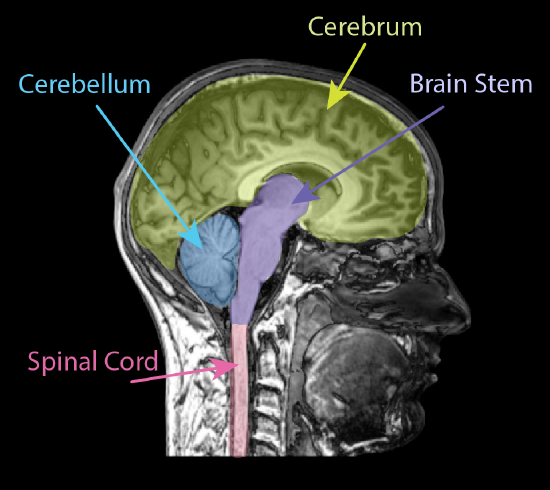
Protective Coverings of the Central Nervous System
The central nervous system (CNS) is crucial to the operation of the body and any compromise of function in the brain and spinal cord can lead to severe difficulties. Both the brain and spinal cord are protected by multiple structures. First, the bones of the skull enclose and house the brain, and the bones of the vertebral column enclose and protect the spinal cord. Figure 4.2.6 shows a segment of the spinal cord within its protective vertebra.
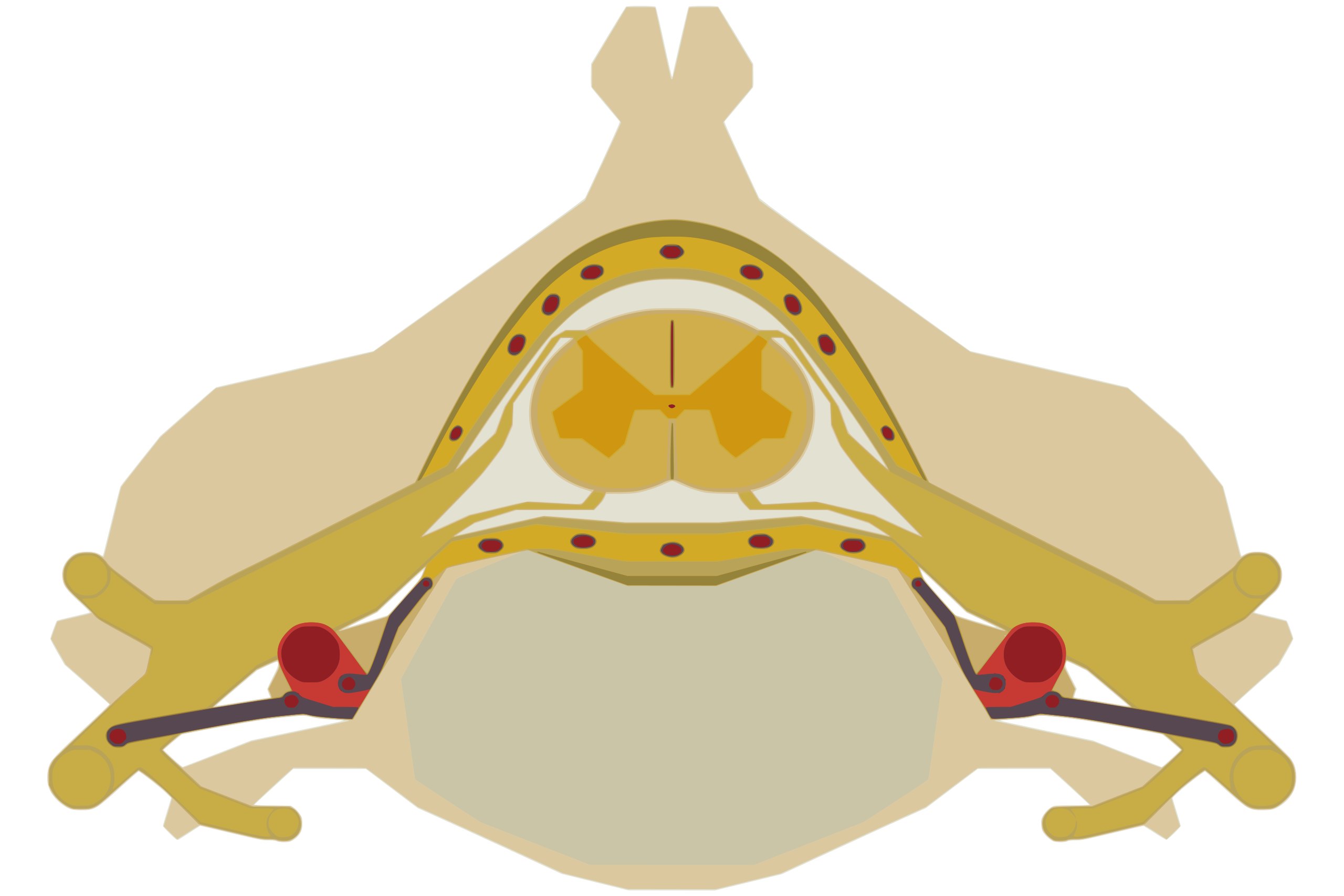
Underneath the skeletal structures, the brain and spinal cord are surrounded and protected by tough meninges, a three-layer protective sheath made of connective tissue that surrounds, supports, stabilizes and partitions the nervous tissue. The meninges also contain cushioning cerebrospinal fluid (CSF). The three meningeal layers are the dura mater, the arachnoid mater, and the pia mater. Figure 4.2.7 shows the three layers of meninges covering the spinal cord and Figure 4.2.8 shows all the protective structures of the brain. The subdural cavity of the spinal cord and the subdural space of the brain lie between the dura mater and the arachnoid mater, whereas the subarachnoid cavity of the spinal cord and the subarachnoid space of the brain lie between the arachnoid mater and the pia mater. The superior sagittal sinus is a space between layers of dura mater immediately superior to the longitudinal fissure (the separation between the left and right hemispheres) of the brain.
In the spinal cord, the posterior (/dorsal) and anterior (/ventral) roots converge to form the spinal nerve. The spinal ganglion (also known as the dorsal root ganglion), an enlargement of the posterior (/dorsal) root, encases sensory neuron cell bodies.
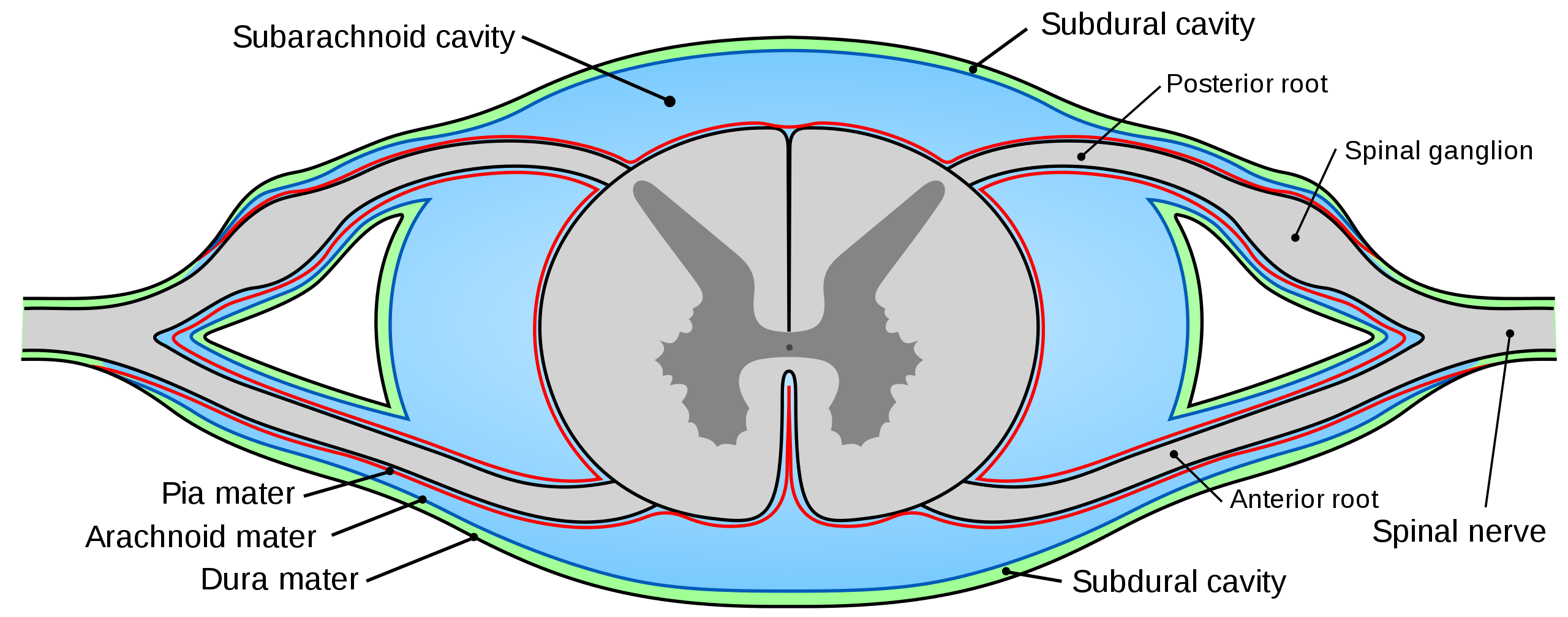
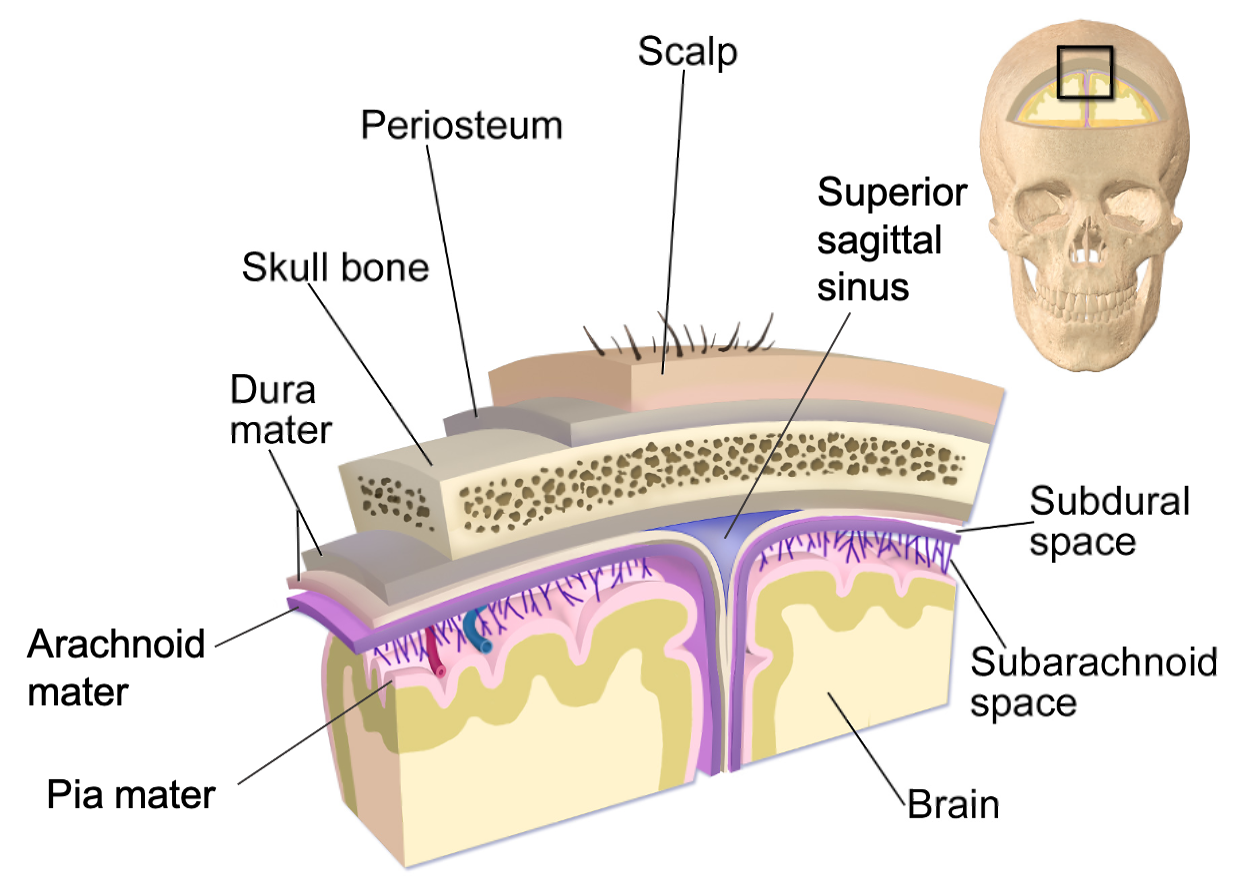
Ventricular System
There are four ventricles within the brain, all of which developed from the original hollow space within the neural tube, the central canal. The ventricles are lined with ependymal cells (a type of glia) that produce cerebrospinal fluid (CSF). The first two ventricles are named the lateral ventricles and are deep within the brain. The two lateral ventricles are shaped like a letter "C" and are located in the left and right hemispheres. (They were originally referred to as the first and second ventricles.) These ventricles are connected to the third ventricle by two openings called the interventricular foramina (plural; "foramen" is the singular term). The third ventricle opens into a canal called the cerebral aqueduct that passes through the midbrain and connects the third ventricle to the fourth ventricle. The fourth ventricle is the space between the cerebellum and the pons and upper medulla. From the fourth ventricle, CSF continues down the central canal of the spinal cord. Figure 4.2.9 illustrates the ventricles, from both a lateral and anterior viewpoint. CSF circulates through the brain and the spinal cord within these structures.
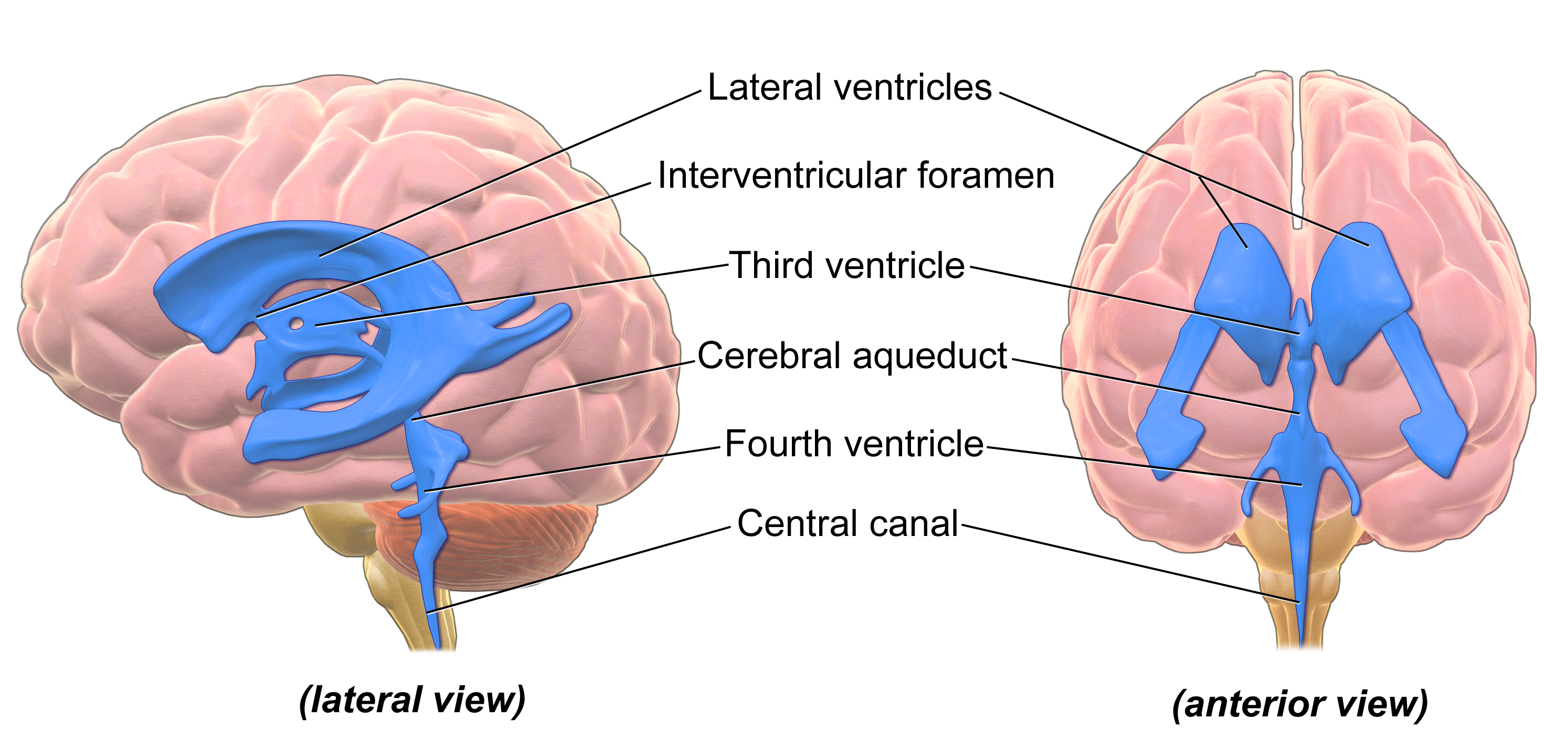
Summary
Anatomical position for humans is standing up, facing forward, with arms extended to the sides, and palms facing out. Anatomical planes are the different directions a body is cut to reveal different views of its internal structures, which include frontal (coronal) planes, separating the front from the back, transverse (horizontal) planes, separating the top from the bottom, and sagittal planes, separating the left and right halves. A midsagittal (or median) plane is exactly on the center line and a parasagittal plane divides the left and right halves unevenly. Pairs of anatomical directional terms are used to make comparisons between one structure with respect to the position of a second structure. These include superior (above) versus inferior(below), proximal (near) versus distal (far), medial (towards the middle) versus lateral (towards the edge, anterior (front) versus posterior (back), ventral (belly-side) versus dorsal (back-side), and superficial (closer to the surface) versus deep (farther from the surface).
The organization of the nervous system includes six divisions. The CNS includes the brain and spinal cord, and the PNS consists of all other nervous tissue in the body. The nerves of the PNS connect the CNS to the rest of the body. The PNS is further divided into the autonomic and somatic nervous systems. The somatic nervous system (SNS) is responsible for activities that are under voluntary control and awareness. The autonomic nervous system (ANS) controls involuntary activities. The autonomic nervous system also has two divisions: the sympathetic and parasympathetic nervous systems. The sympathetic nervous system controls response during emergencies, and the parasympathetic nervous system controls the routine functions of the body.
The adult CNS is separated into four major regions: the cerebrum, the brainstem, the cerebellum, and the spinal cord. Anatomical structures help to protect and isolate the CNS, including the skull (surrounding the brain) and the vertebral column (surrounding the spinal cord). Layers of connective tissue called meninges support and stabilize the brain and spinal cord, as well as partition the brain into specific regions. The outer layer is the dura mater, the middle layer is the arachnoid mater and the inner layer is the pia mater.
The ventricular system is composed of four fluid-filled ventricles in the brain (two lateral ventricles, the third ventricle and the fourth ventricle) which connect to each other (via the interventricular foramina and the cerebral aqueduct) and the central canal of the spinal cord. Cerebrospinal fluid (CSF) circulates through the brain and the spinal cord within these structures.
References
Basinger H., & Hogg, J.P. (2021) Neuroanatomy, Brainstem. In: StatPearls [Internet]. Treasure Island (FL): StatPearls Publishing; 2022 Jan-. Available from: https://www.ncbi.nlm.nih.gov/books/NBK544297/
Additional Resources
If you are curious about anatomical terms used to describe different areas of the body, see "Anatomical Vocabulary" on: " Anatomical Position and Planes" by LibreTexts, licensed under CC BY-SA .
For more detail on the embryological development of the brain and the primary and secondary brain vesicles, see: " The Embryologic Perspective" by OpenStax, LibreTexts, licensed under CC BY .
For more detail on the meninges and the ventricles, see: " Support and Protection of the Brain" by Whitney Menefee, Julie Jenks, Chiara Mazzasette, & Kim-Leiloni Nguyen, LibreTexts, licensed under CC BY and " Circulation and the Central Nervous System" by OpenStax, LibreTexts, licensed under CC BY .
Attributions
- Figures:
- Human Body by Mikael Häggström derivative work: Lamilli (talk)Taken at City Studios in Stockholm (www.stockholmsfotografen.se), September 29, 2011, with assistance from KYO (The organisation of life models) in Stockholm. Both models have consented to the licence of the image, and its usage in Wikipedia. Images uploaded by Mikael Häggström., Public domain, via Wikimedia Commons.
- Human Head Anatomical Planes by Jon Richfield is licensed under CC BY-SA 4.0 via Wikimedia Commons; modified labels from " Anatomical Position and Planes" by LibreTexts is licensed under CC BY-SA . And Sectional Planes of the Brain by Bruce Blausen is licensed under CC BY 3.0 via Wikimedia Commons. [Blausen.com staff (2014). "Medical gallery of Blausen Medical 2014". WikiJournal of Medicine 1 (2). DOI:10.15347/wjm/2014.010. ISSN 2002-4436.]
- CC-BY-SA, Osteomyoamare, WikiMedia. (both views of entire body).And CC-BY-SA, Marshall Strother, WikiMedia; modified labels from " Anatomical Position and Planes" by LibreTexts is licensed under CC BY-SA . Illustration of deep/superficial terms adapted by Suzanne Wakim from CT of a normal brain, axial 18.png by Mikael Häggström, M.D, licensed CC0 1.0 via Wikimedia Commons.
- Nervous System Flowchart by Suzanne Wakim dedicated CC0. From " Introduction to the Nervous System" by Suzanne Wakim & Mandeep Grewal, LibreTexts is licensed under CC BY-NC .
- Adapted by Suzanne Wakim from MRI brain sagittal section.jpg by everyone's idle, licensed CC BY-SA 2.0 via Wikimedia Commons.
- Time3000 is licensed under CC BY-SA 2.5 via Wikimedia Commons
- Mysid, Public domain, via Wikimedia Commons
- "Cranial meninges" by Chiara Mazzasette is licensed under CC BY 4.0 / A derivative of Blausen 0110 BrainLayers.png
- "Blausen 0896 Ventricles Brain" by BruceBlaus is in the Public Domain, CC0
- Text adapted from:
- " Anatomical Position and Planes" by LibreTexts is licensed under CC BY-SA .
- " Introduction to the Nervous System" by Suzanne Wakim & Mandeep Grewal, LibreTexts is licensed under CC BY-NC .
- " The Central Nervous System" by OpenStax, LibreTexts is licensed under CC BY .
- " Support and Protection of the Brain" by Whitney Menefee, Julie Jenks, Chiara Mazzasette, & Kim-Leiloni Nguyen, LibreTexts is licensed under CC BY .
- " Central Nervous System" by Suzanne Wakim & Mandeep Grewal, LibreTexts is licensed under CC BY-NC .
- Changes: Text (and most of the images) from above four sources pieced together with some modifications, transitions and additional content (and images) added by Naomi I. Gribneau Bahm, PhD., Psychology Professor at Cosumnes River College, Sacramento, CA.


